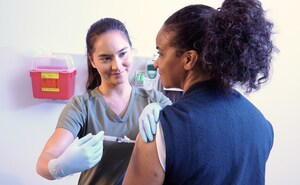Leading Hospital Shares How it Reduced Needlestick Injuries by Nearly 70 Percent
Data-driven approach and implementation of BD Vacutainer® Push Button Blood Collection Sets help drive change at Robert Wood Johnson University Hospital
FRANKLIN LAKES, N.J., May 13, 2014 /PRNewswire/ -- An article published in the Spring 2014 issue of the Journal of the Association of Occupational Health Professionals in Healthcare discusses how a systematic, data-driven approach and the subsequent adoption of a safety-engineered blood collection set helped Robert Wood Johnson University Hospital (RWJUH), a leading academic medical center, reduce needlestick injuries (NSIs) by nearly 70 percent among its patient care technicians and nursing staff.
In the article – "Successfully Reducing Wingset-related Needlestick Injuries" – author Doris L. Dicristina, RN, BSN, MS, COHN-S/CM, Director – Employee Health and Wellness Services for RWJUH, reports how her team identified that forward-shielding safety blood collection sets accounted for 30 percent of the institution's NSIs in 2010 and 43 percent in 2011.
The financial impact of these NSIs on RWJUH ranged from $400-$6,000 per injury, depending on whether the patient was known to carry a bloodborne disease such as hepatitis C, hepatitis B or HIV/AIDS. Using a novel financial model, RWJUH estimated that it would need to generate more than $106,000 in additional revenue to cover the cost of each NSI from a source-negative patient, with injuries from source-positive patients costing even more.
"Our first instinct in 2010 was to retrain...," Dicristina wrote. "It became clear that retraining – although important – was not the solution, and that the current engineering control was in fact the problem."
Further investigation revealed that approximately 83 percent of injuries with the forward-shielding safety blood collection sets occurred after clinicians removed the needles from their patients' veins, but before they activated the safety mechanism. After an extensive search and evaluation of different safety blood collection sets, the hospital selected the BD Vacutainer® Push Button Blood Collection Set (PBBCS), with a split-second retracting needle that offers in-vein safety activation.
The study reports that, after staff training and full conversion to the new safety device, NSIs at RWJUH dropped nearly 70 percent from 45 injuries in 2010 and 2011 to 14 in 2012 and 2013. The injury rate per 100,000 devices purchased fell more than 64 percent – from 7.43 in 2010-2011 to 2.65 in 2012-2013.
"This case study shows how having the right engineering control, along with commitment from all levels of an organization, can help achieve and sustain dramatic reductions in needlestick injuries," said Ana K. Stankovic, MD, PhD, MSPH, Worldwide Vice President of Medical Affairs for BD Diagnostics – Preanalytical Systems.
"Part of a strong organizational and institutional safety culture is the willingness to take a systematic, data-driven approach to investigating and addressing these issues," Dicristina concluded. "Despite the increase in device cost, RWJUH elected to do what is right for the clinicians who perform the procedures in question and live with their associated risks every day. Protecting and saving their lives was the focus, and, RWJUH is now beginning to see the cost savings."
About BD
BD is a leading medical technology company that partners with customers and stakeholders to address many of the world's most pressing and evolving health needs. Our innovative solutions are focused on improving drug delivery, enhancing the diagnosis of infectious diseases and cancers, supporting the management of diabetes and advancing cellular research. We are nearly 30,000 associates in 50 countries who strive to fulfill our purpose of "Helping all people live healthy lives" by advancing the quality, accessibility, safety and affordability of healthcare around the world. For more information, please visit www.bd.com.
About Robert Wood Johnson University Hospital
Robert Wood Johnson University Hospital (RWJUH) is a 600-bed academic medical center which is the flagship Cancer Hospital of Rutgers Cancer Institute of New Jersey and the principal hospital of Rutgers Robert Wood Johnson Medical School in New Brunswick, NJ. Robert Wood Johnson is an innovative leader in advancing state-of-the-art care. Its Centers of Excellence include cardiovascular care from minimally invasive heart surgery to transplantation, cancer care, and women's and children's care including The Bristol-Myers Squibb Children's Hospital at Robert Wood Johnson University Hospital (www.bmsch.org). The hospital is also a Level 1 Trauma Center and serves as a national resource in its ground-breaking approaches to emergency preparedness. The hospital has earned significant national recognition for clinical quality and patient safety. RWJUH has been ranked among the best hospitals in America by U.S.News & World Report six times and has been selected by the publication as a high performing hospital in several specialties. The Bristol-Myers Squibb Children's Hospital has also ranked among the nation's Best Children's Hospitals by U.S.News & World Report for two consecutive years. The American College of Surgeons' Commission on Cancer has rated RWJUH among the nation's best comprehensive cancer centers and the hospital's Comprehensive Stroke Center is certified by the Joint Commission to provide complex stroke care. The Leapfrog Group rated RWJUH as one of the 50 exceptional U.S. hospitals, as published in Consumers Digest magazine, and has given the hospital an "A" grade for safety and quality. Harvard University researchers, in a study commissioned by The Commonwealth Fund, identified RWJUH as one of the top 10 hospitals in the nation for clinical quality. RWJUH is also a four-time recipient of the prestigious Magnet Award for Nursing Excellence. Visit us online at www.rwjuh.edu.
Contact:
Abigail Cardona
BD Public Relations
(201) 847-4605
[email protected]
SOURCE BD (Becton, Dickinson and Company)
WANT YOUR COMPANY'S NEWS FEATURED ON PRNEWSWIRE.COM?
Newsrooms &
Influencers
Digital Media
Outlets
Journalists
Opted In





Share this article